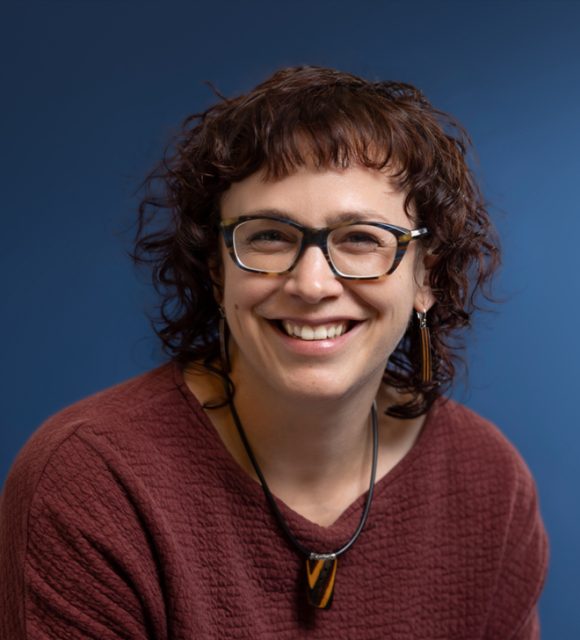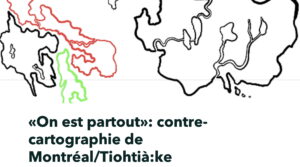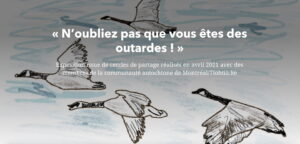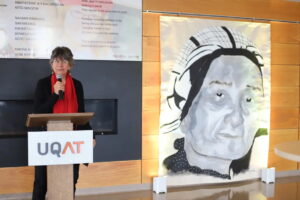
Looking for students or interns
Areas of expertise
Decolonization of research, academic institutions and urban spaces
- Assistant Professor
- INRS-UQAT Joint Research Unit | Indigenous Studies regular member
- Co-Chair of the Joint Management Committee of the INRS-UQAT Joint Research Unit | Indigenous Studies
Email:
marie-eve.drouin-g@inrs.ca
Phone:
To come
Urbanisation Culture Société Research Centre
385 Sherbrooke Street E.
Montreal, Quebec H2X 1E3
Canada
Université du Québec en Abitibi-Témiscamingue
663 First Avenue
Val-d’Or, Quebec J9P 1Y3
Research interests
- Indigenous higher education, indigenous pedagogies and pedagogies by the territory;
- Urban indigenous experiences, colonialist cities and indigenous cities;
- Colonial and de-colonial processes in the Americas;
- Decolonial approaches;
- Indigenous methodologies and epistemologies, participatory and collaborative methodologies, narrative cartographies;
- Quebec, Canada, United States and South America (Andean context).
Storymap: «On est partout»: contre-cartographie de Montréal/Tiohtià:keDescription«On est partout»: contre-cartographie de Montréal/Tiohtià:ke (in French only) was posted on the ArcGIS StoryMap platform in May 2021. It presents the research process conducted with seven Montréal Indigenous youth. Although punctuated by the participants’ words, it does not share the results of their reflections, but rather the participatory process that made it possible to co-create new knowledge about their relationships in and with the city. The stages of the process, the themes addressed, and the principles implemented in this research process are presented. Target audienceGeneral public and other researchers (for methodology). Co-construction or partnershipWork carried out with seven Indigenous youth living in Montréal as part of a collaborative research process with Professor Stéphane Guimont Marceau. See the publication: «On est partout»: contre-cartographie de Montréal/Tiohtià:ke |
 |
Confluences interactive map (in French only)DescriptionThis map shows the weaving, or confluence, of stories by Indigenous youth from Tiohtiá:ke/Moonyiang. Their individual stories come together to tell a collective story of Indigenous experiences in the city, like beads assembled into a beading project. The map is a non-georeferenced artistic representation of Montréal by Fabienne Théorêt Jérôme. Clicking on the flowers (themes) or petals (subthemes) plays excerpts from the stories shared by the young people who participated in the project. Target audienceGeneral public, including the population of Montréal. Co-construction or partnershipThe map is the result of a research project begun in 2019 with young people from the Montreal/Tiohtiá:ke Indigenous community concerning their relationships with and in the city. This collaborative research project used participatory mapping to share their stories, experiences, and knowledge of and in the city, while spurring collective analysis and the co-creation of new knowledge and perspectives. A total of 18 young people age 18 to 35 took part in the project through mapping workshops and semi-structured interviews. Two elders supported them during the workshops. The young people were from the Innu, Atikamekw, Kanien’kehá:ka, Anishinaabe, Dene, Waban-Aki, Wendat, Inuit, and Métis nations. A creative committee of nine young research participants was formed in fall 2021. Analysis of the stories collected was carried out in part by this committee. Project with Professor Stéphane Guimont Marceau. Learn more: Confluences interactive map |
 |
Virtual exhibition: “N’oubliez pas que vous êtes des outardes” (in French only)DescriptionVirtual exhibition for the First Peoples’ Festival during the COVID-19 pandemic (hence the virtual presentation on the ArcGIS StoryMap platform), August 2021. This photovoice exhibition is the result of sharing circles held in April 2021 with members of the Montréal/Tiohtià:ke Indigenous community from different nations. The photos and captions were proposed by participants to fuel discussions about their connections with Montréal and in the city’s public spaces. The photos and captions are presented by theme, then in a georeferenced map that shows where in Montréal the photos were taken. Target audienceGeneral public, population of Montréal, First Peoples’ Festival participants. Co-construction or partnershipThe photovoice process is a participatory visual approach to research that enables the co-construction of knowledge between participants and with researchers. These transgenerational exchanges are part of a collaborative research project between a team from the Institut national de la recherche scientifique (INRS) Urbanisation Culture Société Research Centre and Mikana concerning relations between Indigenous and non-Indigenous people in urban spaces in Québec. Project with Professor Stéphane Guimont Marceau. See the publication : N’oubliez pas que vous êtes des outardes ! |
 |
Exhibition: Aki Tipatcimo : raconter le territoire en rendant hommage à celles et ceux qui l’ont vécu (in French only)DescriptionThis multidisciplinary exhibition combines painting, oral tradition, and poetry. The project was inspired by a poem by Alice Jérôme, an Anishinaabe elder from Pikogan, and testimonials gathered during the Aki Tipatcimo (Anishinaabemowin for “telling the story of the land”) workshop held in March 2023 at UQAT’s participatory mapping laboratory. The paintings on display—eight large portraits of Indigenous elders—are by Virginia Pesemapeo Bordeleau. This exhibition pays tribute to those who have experienced the land and its dispossession and who have survived the multiple traumas that ensued. The exhibition officially opened on September 23, 2024, as part of week-long activities to mark the National Day for Truth and Reconciliation at UQAT. It ran until December 6, 2024. Target audienceUniversity community (UQAT) and general public invited to the launch Co-construction or partnershipExhibition based on testimonials gathered during the Aki Tipatcimo workshop held in March 2023 at UQAT’s participatory mapping laboratory. Aki Tipatcimo means “tell the story of the land” in Anishinaabemowin. We chose this title for the workshop because that’s what maps do: tell the story of the land from a given perspective. The event brought together dozens of people from a wide range of backgrounds: members of the Val-d’Or Indigenous community and the communities of Kitcisakik, Lac Simon, and Pikogan; professors from UQAT’s School of Indigenous Studies and the INRS Urbanisation Culture Société Research Centre; master’s and PhD students from UQAT’s School of Indigenous Studies; members of UQAT’s Mamawi Mikimodan Service and Continuing Education Service; representatives of the City of Val-d’Or; and committed citizens from the region. The objective was to spur conversation, encourage collaboration, and explore ways to reappropriate the urban space of Val-d’Or as an Indigenous space. Exhibition produced in collaboration with UQAT’s Mamawi Mikimodan Service and participatory mapping laboratory, and in collaboration with Indigenous artists Virginia Pesemapeo Bordeleau and Alice Jerome. See the publication: Lancement de l’exposition Aki Tipatcimo |

|

